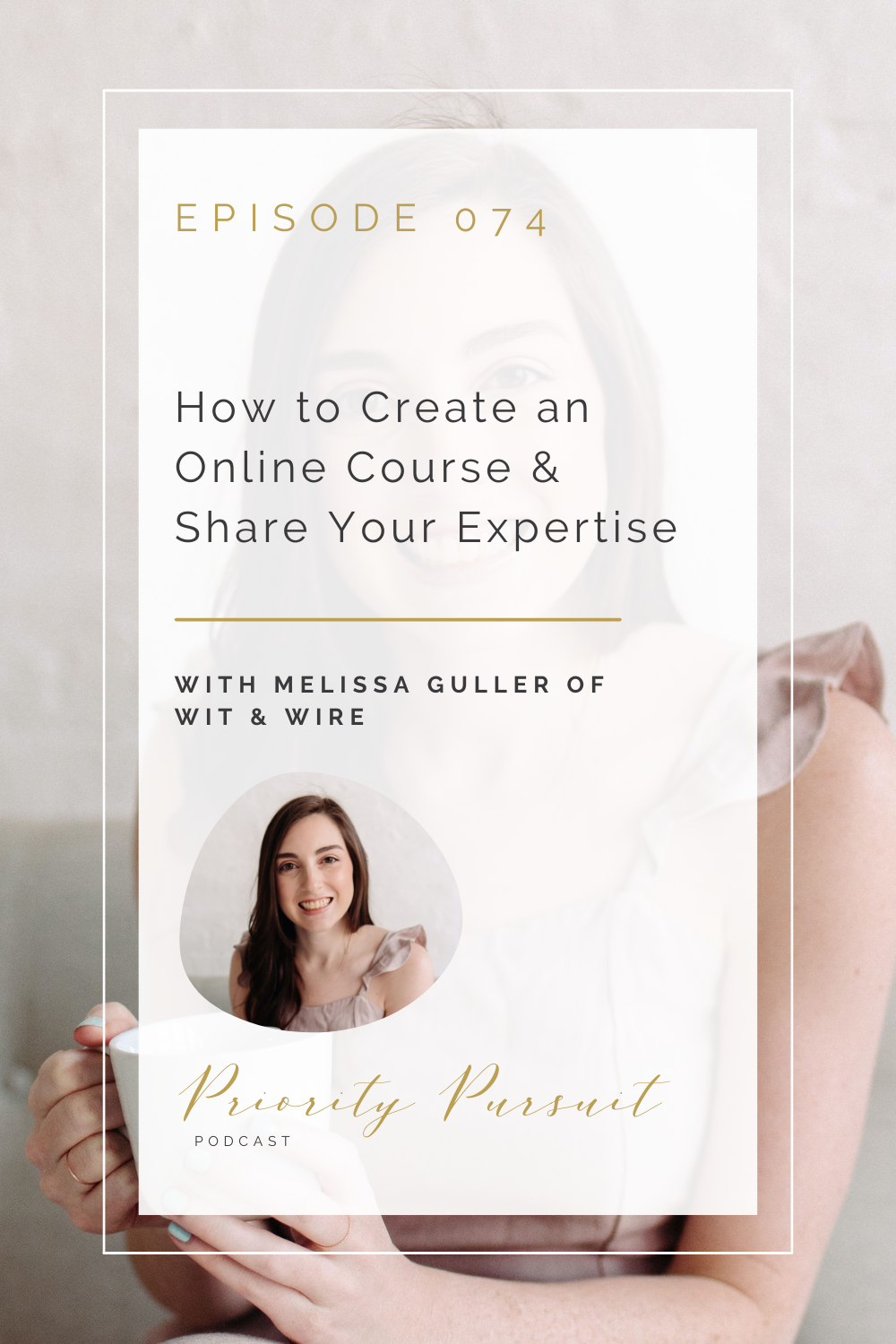Let's Connect!
Check Out Wedding Photography Packages]
I understand how much your wedding photos mean to you and how much work you’re putting into planning every last detail of your big day. As a VRP bride, you can relax and enjoy your wedding day knowing you’ve chosen a team of photographers who are just as detail-oriented as you are, will put thought into every shot, and will pay attention to all of the little details to ensure that you and your spouse love your wedding photos.
And, I’m an Indy wedding photographer for the type-A bride.
I'm Victoria Rayburn
Hey there!
Episode 074: How to Create an Online Course & Share Your Expertise with Melissa Guller of Wit & Wire
Spotify | Apple Podcasts | Stitcher
As a creative entrepreneur, you’re an expert (or you soon will be!) in your field. And, you might like to find a way to teach others what you’ve learned so you can make additional income and an impact. So, how can you sell your knowledge and serve your fellow industry professionals?
Well, course creation may be just what you’ve been looking for! Creating an online course—and selling it to others in your industry—will let you do what you love, earn more money, and give your students tools to improve their skills. And, today’s guest, Melissa Guller, is on a mission to help small business owners do just that: share their expertise by adding online courses to their growth strategy.
Melissa is the founder and CEO of Wit & Wire, where she helps online business owners share their expertise and reach a wider audience with podcasting. She’s worked for Ramit Sethi at Teachable and produced multiple U.S. Top 50 Podcasts, and her top-ranking podcast, Everything is Teachable, came in as the #2 Career Podcast in America. Melissa has also helped almost 2,000 podcasters through her Wit & Wire programs, and she loves teaching entrepreneurs with her online courses on podcasting and course creation. Building and selling these courses has allowed Melissa to increase her revenue and enjoy more freedom in her personal life.
In this episode of Priority Pursuit, Melissa explains how to create an online course so you can share your expertise with other industry professionals. She also provides tips for selling your offer, budgeting for course creation, making time in your schedule to create courses, and more.
When (& why) should creative entrepreneurs create an online course?
Creatives and online business owners often wonder if they need a huge audience before selling courses. But, even if you don’t have many followers, Melissa would encourage you to start thinking about course creation today. She suggests reaching out to your current audience—in person, on social media, or both—to see who may be interested in taking a course. Melissa says you might even be ready to create an online course if you already have some momentum, like a few hundred subscribers on your email list.
But, whether you have 20, 200, or 2,000,000 followers, building a course that teaches a wider audience at once can help you save time while growing your business. “You’ll hit a tipping point where your revenue goals will be higher than the amount of time you’ll want to put in with one-on-one clients,” Melissa says. In other words, you’ll get to the point where exclusively working with individuals takes up more time than you’d like—and, courses will allow you to serve multiple clients and earn more money simultaneously.
Melissa recommends asking yourself a few questions before you create an online course:
- What outcome can I help people reach?
- What goal or unmet desire do they have?
- How can I help them meet that goal or desire?
You’re probably considering these questions already as a service provider, so it might be easier than you think to translate your expertise into an online course. For example, if you’re a Squarespace designer, you have an established process of helping clients build custom websites. So, you can take that process and turn it into an online course that teaches students how to design their own sites. Then, you can directly help a group of people who want to create their own website by creating and selling a course tailored to their needs and goals.
What steps should creatives follow to outline, design, & sell their online courses?
Melissa breaks down course creation into three stages (each with different marketing and teaching strategies): validate, elevate, and automate.
Stage 1: Validate
During the validation stage, you’ll ensure you have followers or subscribers who actually want to buy and take your online course (AKA validate demand). “First, you should get really clear about who the course is for and what outcome they’ll achieve by the end of the program,” Melissa says. For instance, your Squarespace course audience would be business owners who want to learn how to build their own websites. These business owners will be the group of people you outline and design a course for, then work directly with as their instructor to help them create custom websites for their businesses.
But, although you may want to design an entire course at once for your audience, you first need to validate demand. Melissa suggests doing this with a founders’ round (AKA a pilot or beta program), which is a small group of people who are ready to commit to buying and taking the very first version of your course. This first iteration is your minimum viable product (MVP), which Melissa describes as the first experience you’ll sell early in the course creation process to interested followers (AKA your founders). Enrolling these early-adopter founders in your course will allow you to get paid up front for your MVP (the course).
Stage 2: Elevate
Next, in the elevation stage, you’ll create a scalable asset (AKA your online course) that’s easy to update and improve once you receive feedback from the founders’ round. But, you’ll create a weekly curriculum outline—and lessons for the first couple of weeks— instead of designing the entire course at once. So, when your founders buy the course and first log on, they won’t see a complete course, but rather an outline of the syllabus and a handful of modules. This will allow your students to provide feedback on the lessons you’ve taught so far, and you can use their comments to adjust the rest of your curriculum as necessary before finishing the course.
You can teach live or pre-recorded classes, but Melissa suggests live instruction, if possible, so you can have more face time with your students and get direct feedback from them. Along with requesting constructive criticism, you can also ask your students if they’d be willing to provide positive reviews sharing what they enjoyed about the course, what skills they’ve gained, and more. Then, you can use these testimonials to market the new-and-improved version of your course to more potential students.
Stage 3: Automate
After you’ve taught your founders, improved your curriculum, and finished designing your course, it’s time for the automation stage. Now, you’ll have the opportunity to earn passive income—which Melissa says everyone wants from an online course, but doesn’t actually see happen until the automation stage. In other words, you first have to put the time into validating demand, selling to early adopters for your founders’ round, creating a curriculum outline and the first few lessons, receiving feedback, improving and finishing your course, and marketing the course.
Once you know your course is helpful to students (and profitable for you), then you’ll be able to start earning passive income by automating course sales, online sign-ups, and instruction. You can also shift from teaching a small group to marketing to a wider audience—and, by letting more students opt in on your website or via email, you can literally market and sell the course in your sleep!
How can creative entrepreneurs sell their courses?
Melissa typically sees two groups of creative entrepreneurs who are interested in building and selling an online course. Those in Group #1 might have a few hundred in their email lists already from selling a previous offer, or simply from getting subscribers as full-time business owners. If you’re in Group #1, Melissa suggests starting with a survey to your audience where you ask what they’d like to learn from you, and if they’d like to take a course. Based on their feedback, you can sell your followers a course that you’ll design to meet their specific needs and goals.
Group #2 consists of new business owners who may not have an email list or a substantial following yet. If you’re in Group #2, Melissa recommends building your audience with TikTok. That’s right, TikTok! According to Melissa, the social media platform is currently the fastest way to grow your audience and get your content in front of prospects. If you’d like to test out this strategy, Melissa suggests that you start a TikTok account, put yourself on camera, and create content around the topic you want to teach about. If more people begin to follow you and sign up for your email list, this will validate demand for your course (AKA show that people are interested in joining your audience and even buying a course from you). Once you’ve validated demand, you’ll be ready to sell your course to early adopters.
Can creatives still build & sell courses if they have a busy season (for example, wedding photographers in the spring)?
There are only so many hours in the day, and if you have a busy season, you probably don’t have much time to catch your breath, let alone create an online course. Melissa understands this, friend! That’s why she recommends setting course creation aside during your busy season and focusing on lead generation. If you have a freebie on your website (like a PDF) addressing a pain point that would naturally funnel to a course you want to sell, you can market that lead generator on social media, in your emails, and on your website.
Melissa also suggests putting a “Courses” tab in your navigation that directs your website visitors to a simple landing page with a header, a couple of sentences, and an email opt-in. This page could say something like, “Course coming soon! Just provide your name and email address, and I’ll send updates your way.” Then, you can gather interest during your busy season to see who’d like to take an online course once you have more time in your business. As your busy season is ending, you can look for opportunities to teach others and actually build a course.
How much should creative entrepreneurs budget to create an online course?
As Melissa reminds us, you’ll save so much time and money by setting up a founders’ round with a small number of initial lessons (versus creating the entire course before selling it to students). That’s because your founders’ will tell you what worked with your first lessons and what you can improve for the rest of the course—instead of building the whole program, realizing that none of it works well for your students, and having to redo the entire course.
Before you create your online course, Melissa recommends budgeting for (and investing in) this toolkit of software, equipment, and strategies:
- A USB plug-in microphone for quality audio in your lesson recordings: about $100 (a one-time cost)
- A webcam for slide-based course videos (and face time with your students if you’d like): about $60 (a one-time cost)
- An all-in-one course creation platform (like Teachable) to write and design your course, contact students, and receive their payment: about $30-$40 (for a basic monthly subscription)
- A website and an email marketing platform to promote your course: TBD (This monthly cost will vary, based on your marketing budget. You might have invested in a website and email marketing already as an online business owner.)
What kind of income can creatives expect from selling online courses?
If you’re still struggling to believe that you can sell your knowledge online—and that people will happily pay you for it—Melissa wants you to know that you absolutely can! “The potential for online course revenue is nearly limitless,” she says. “More people need to know about this!”
According to Melissa, you can realistically expect to make $5,000 to $10,000 per month by selling your online courses. She suggests charging $250 to $500 for each course, which will help you earn back your initial investment with just a student or two. In other words, even if you still have a small number of followers, you can generate enough income to support the lifestyle you want as you grow your audience (and your online business).
Friend, I hope this conversation with Melissa has shown you how valuable your knowledge is! When you create an online course, you can boost your income, share your expertise with professionals in your field, and help others gain useful skills and reach their goals.
Want to hear more from Melissa?
If you’d like to connect with Melissa and learn more about course creation, visit her website at witandwire.com, and subscribe to the Wit & Wire Podcast. You can also follow her on Instagram, TikTok, and YouTube.
Links & Resources Mentioned in This Episode
The Power of Moments by Chip & Dan Heath
Free Wit & Wire Download: Online Course Toolkit
Listen to the Wit & Wire Podcast
Save 50% on Your First Six Months of QuickBooks Self-Employed
Receive 50% Off Your First Order with Photographer’s Edit
Receive $20 Off Your First Pair of Rothy’s
Join the Priority Pursuit Facebook Community
Follow or DM Victoria on Instagram
Did you enjoy this episode? If so, pin it to save it for later! Follow me on Pinterest for more marketing, business, branding, and boundary-setting strategies!

Let's Connect!
Check Out Wedding Photography Packages]
I understand how much your wedding photos mean to you and how much work you’re putting into planning every last detail of your big day. As a VRP bride, you can relax and enjoy your wedding day knowing you’ve chosen a team of photographers who are just as detail-oriented as you are, will put thought into every shot, and will pay attention to all of the little details to ensure that you and your spouse love your wedding photos.
And, I’m an Indy wedding photographer for the type-A bride.
I'm Victoria Rayburn
Hey there!
© 2023 Victoria Rayburn Photography. All rights reserved. | Terms & Conditions | Privacy Policy
Let's Connect!
@victorialrayburn
Let's Connect! | @victorialrayburn
Schedule a Coffee Date
However, as a VRP bride, you can relax and enjoy your celebration while being confident that every moment and detail is being thoughtfully photographed!

